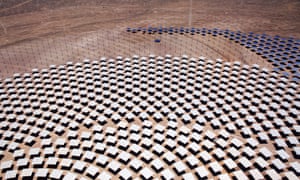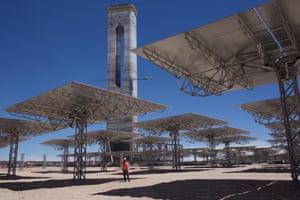Towering 200 metres above the desert, the Atacama 1 will harvest the sun’s energy from a surrounding field of giant mirrors. But the completion of the $1.1bn project, the first of its kind in Latin America, has been thrown into doubt by the financial difficulties of its Spanish owner

Rising more than 200 metres above the vast, deserted plains of the Atacama desert, the second tallest building in Chile sits in such a remote location that it looks, from a distance, like the sanctuary of a reclusive prophet, a temple to ancient gods or the giant folly of a wealthy eccentric.
Instead, this extraordinary structure is a solar power tower that is being built to harvest the energy of the sun via a growing field of giant mirrors that radiate out for more than a kilometre across the ground below with a geometric precision that is reminiscent of contemporary art or the stone circles of the druids.
Still under construction, the Atacama 1 Concentrated Solar Power plant is a symbol of the shift from dirty fossil fuels to a cleaner, smarter way to generate electricity in Chile which is leading the charge for solar in Latin America thanks to its expanses of wilderness and some of the most intense sunlight on Earth.
Following the global climate change deal signed in Paris earlier this month, the $1.1bn project is a source of hope because it demonstrates how far renewable technology has come. But – amid reports of its Spanish owner Abengoa’s financial difficulties – it is also a reminder of how the energy transition is increasingly challenged more by financing uncertainties than engineering obstacles.
The main structure – which is already taller than London’s Gherkin or New York’s Trump Tower – is almost finished. The next big challenge will be to lift one of the heaviest slabs of steel ever made – the 2,000-tonne solar receiver – to the top with hydraulic jacks. This will be used to heat a pool of 50,000 tonnes of molten salt up to temperatures of 565C during the day so it can continue to drive turbines through the night. All that is needed after that is to polish the 10,600 heliostatic mirrors so that they can reflect sunlight up to the tower. The end result will be the dream of sustainable energy supporters – a solar facility that can provide baseload power generation of 110 megawatts (MW) for 24 hours a day.
Although there are other, bigger concentrated solar power plants in the US, this is the first in South America and is believed to be the largest anywhere in the world to use a single tower and locally mined salt for thermal storage and to drive its turbines. The company says the kilowatt hours of solar power per square kilometre in Atacama is more than 30% higher than anywhere else it operates, including the US, Spain and South Africa.
The sun is so powerful in this 1,100m-altitude desert that it can be dangerous. Along with a harness, helmet and boots, the essential safety items for visitors are dark glasses and industrial-strength sunblock lotion. Despite the heat, security guards on the perimeter have have thick uniforms that cover every inch of their skin.
With only two or three cloudy days per year, the intensity and constancy of the light have drawn a growing number of solar companies to the Atacama, which is becoming one of the world’s leading centres of renewable energy.
The transformation has been eye-opening. As well as the concentrated solar power, the plant also has a 100MW of conventional photovoltaic generation, as well as a production line where assembly workers turn out 36 heliostats each day. They are then lifted on to trucks and transported to the field of mirrors.
“Can you imagine what it was like when I first arrived here three years ago? There was nothing. No animals. Not even a scorpion,” recalls Herrera, who said his company was now planning new plants in the north and south of the country. “Chile and South Africa are now the biggest growth areas for our company’s solar power division.”
That ambition may have to be put on hold. Despite the strong position of the Atacama 1 plant, which has a 20-year contract at a fixed and profitable price to sell to the local grid (which will then uses most of the electricity to meet the demands of industry, such as Chuquicamata, – the world’s biggest open pit copper mine), Abengoa is perilously deep in debt. Following an over-leveraged global expansion, the company filed earlier this month for preliminary protection from creditors.
Even before the restructuring was announced, company executives acknowledged that Atacama 1 was a stretch because there are no direct subsidies in Chile.
“This will be an iconic project that reduces 840,000 tonnes of carbon emissions per year,” said Ivan Araneda, general director of Abengoa Solar Chile. “But we have to compete with conventional generation, so we have the challenge of reducing costs to be more competitive. The financing for these facilities is a challenge.”

The plant’s future is now in doubt while the company reorganises. But the spread of solar in the Atacama is not reliant on one player. In the past eight years, the share of non-conventional renewable energy (wind, solar and biomass) in Chile’s energy mix has risen from 1% to 11% and continues to grow at the rate of about 600MW per year. The government, which offers long-term contracts to private sector bidders, said it was confident of achieving its target of 20% by 2025. Costs are falling rapidly.
“Renewables are now as competitive as conventional energy, and we don’t have subsidies. Instead, we have a natural subsidy of great photovoltaic potential,” said Paula Estevez, the international affairs chief at the Ministry of Energy, who said one-third of energy projects under construction were solar.
Clusters of blue photovoltaic panels are now an increasingly common sight, as the Guardian saw near Copiapo, a city about eight hours’ drive south of the Atacama 1 plant through a desert that is covered in some stretches with purple, yellow and red flowers as a result of unusual El Niño floods earlier this year.
There are several solar plants on this energy corridor, including the 101MW facility in Amanecer, which is currently the largest operating in Chile. On a broad plain between sand dunes and rocky crags are 312,000 panels that track the sun throughout the day. Owned by US firm SunEdison, it is a low maintenance operation: only 15 workers are needed to clean and monitor the modules. With prices fixed for two decades, long-term profits are guaranteed. This has brought in a flood of investment. Further along the road are two other SunEdison plants. Rival firms, including First Solar, are building other facilities nearby.
“It’s amazing how quick the growth has been,” said Caminho Galleguillos, an engineer at the Amanecer plant.
With so much interest, the government tenders have been oversubscribed, driving down bidding prices.
“Chile is a unique market in that solar is cheaper than coal. This will influence what will happen. We see it as a strategic market and a market leader in the solar field,” said Carlos Barrera, vice-president of SunEdison, aims to generate 600MW at its plants in Chile by the end of 2016.
Such rapid growth has excited environmental campaigners , who see non-conventional renewables as an alternative to dams as well as a possible source of revenue for the nation and energy for the entire region.
“In solar alone, we have 1,000 gigawatts of generation potential, but domestic demand is less than 20GW. In future, we could export energy to other Latin American countries,” said Patricio Rodrigo, the executive director of the Chile Ambiente corporation.

There is certainly enough sunlight. But the dream of using Atacama to power swaths of South America is still a long way from being realised. Transmission networks are insufficiently developed to send the electricity even to Santiago, let alone neighbouring nations.
In the near future, Chile plans to link its northern and central grids. But beyond that, any cross-border network expansion will have to contend with the Andes mountain range.
That is a tough but not insurmountable challenge. The engineering skill is there. The technology is there. And the sunlight is certainly there. All that is needed is the finance. But as Abengoa has discovered to its cost, without money the lights can quickly dim on even the brightest solar plans.
